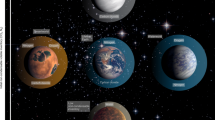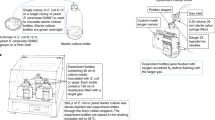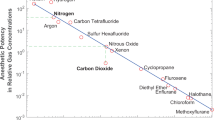Abstract
As oxygen is essential for respiration and metabolism for multicellular organisms on Earth, its presence may be crucial for the development of a complex biosphere on other planets. And because life itself, through photosynthesis, contributed to creating our oxygen-rich atmosphere, oxygen has long been considered as a possible biosignature. Here we consider the relationship between atmospheric oxygen and the development of technology. We argue that only planets with substantial oxygen partial pressure (\(p_{{\mathrm{O}}_2}\)) will be capable of developing advanced technospheres and hence technosignatures that we can detect. But open-air combustion (needed, for example, for metallurgy), is possible only in Earth-like atmospheres when \(p_{{\mathrm{O}}_2}\) ≥ 18%. This limit is higher than the one needed to sustain a complex biosphere and multicellular organisms. We further review other possible planetary atmospheric compositions and conclude that oxygen is the most likely candidate for the evolution of technological species. Thus, the presence of \(p_{{\mathrm{O}}_2}\) ≥ 18% in exoplanet atmospheres may represent a contextual prior required for the planning and interpretation of technosignature searches.
This is a preview of subscription content, access via your institution
Access options
Access Nature and 54 other Nature Portfolio journals
Get Nature+, our best-value online-access subscription
$29.99 / 30 days
cancel any time
Subscribe to this journal
Receive 12 digital issues and online access to articles
$119.00 per year
only $9.92 per issue
Buy this article
- Purchase on Springer Link
- Instant access to full article PDF
Prices may be subject to local taxes which are calculated during checkout


Similar content being viewed by others
References
Knoll, A. H. The Precambrian evolution of terrestrial life. In The Search for Extraterrestrial Life: Recent Developments (ed. Papagiannis, M. D.) 201–211 (Springer, 1985).
Catling, D. C., Glein, C. R., Zahnle, K. J. & McKay, C. P. Why O2 is required by complex life on habitable planets and the concept of planetary ‘oxygenation time’. Astrobiology 5, 415–438 (2005).
Judson, O. P. The energy expansions of evolution. Nat. Ecol. Evol. https://doi.org/10.1038/s41559-017-0138 (2017).
Socas-Navarro, H. et al. Concepts for future missions to search for technosignatures. Acta Astronaut. 182, 446–453 (2021).
Wright, J. T. et al. The case for technosignatures: why they may be abundant, long-lived, highly detectable, and unambiguous. Astrophys. J. Lett. 927, L30 (2022).
Catling, D. C. & Kasting, J. F. Atmospheric Evolution on Inhabited and Lifeless Worlds (Cambridge Univ. Press, 2017).
Rye, R. & Holland, H. D. Paleosols and the evolution of atmospheric oxygen; a critical review. Am. J. Sci. 298, 621–672 (1998).
Lyons, T. W., Reinhard, C. T. & Planavsky, N. J. The rise of oxygen in Earth’s early ocean and atmosphere. Nature 506, 307–315 (2014).
Buick, R. When did oxygenic photosynthesis evolve? Phil. Trans. R. Soc. B 363, 2731–2743 (2008).
Catling, D. C. & Zahnle, K. J. The Archean atmosphere. Sci. Adv. https://doi.org/10.1126/sciadv.aax1420 (2020).
Berner, R. A. GEOCARBSULF: a combined model for Phanerozoic atmospheric O2 and CO2. Geochim. Cosmochim. Acta 70, 5653–5664 (2006).
Berner, R. A. Phanerozoic atmospheric oxygen: new results using the GEOCARBSULF model. Am. J. Sci. 309, 603–606 (2009).
Krause, A. J., Mills, B. J. W., Merdith, A. S., Lenton, T. M. & Poulton, S. W. Extreme variability in atmospheric oxygen levels in the late Precambrian. Sci. Adv. https://doi.org/10.1126/sciadv.abm8191 (2022).
Budisa, N., Kubyshkin, V. & Schulze-Makuch, D. Fluorine-rich planetary environments as possible habitats for life. Life 4, 374–385 (2014).
Knoll, A. H. Food for early animal evolution. Nature 548, 528–530 (2017).
Planavsky, N. J. et al. Low mid-Proterozoic atmospheric oxygen levels and the delayed rise of animals. Science 346, 635–638 (2014).
Lingam, M. & Loeb, A. Life in the Cosmos: From Biosignatures to Technosignatures (Harvard Univ. Press, 2021).
Went, F. W. The size of man. Am. Sci. 56, 400–413 (1968).
Jones, D. & Kaufman, M. Combusion of hydrocarbons on purified fluorine. Combust. Flame 67, 217–221 (1987).
Razus, D. Nitrous oxide: oxidizer and promoter of hydrogen and hydrocarbon combustion. Ind. Eng. Chem. Res. 61, 11329–11346 (2022).
Biteau, H., Fuentes, A., Marlair, G. & Torero, J. The influence of oxygen concentration on the combustion of a fuel/oxidizer mixture. Exp. Therm. Fluid Sci. 34, 282–289 (2010).
Gowlett, J. A. J. The discovery of fire by humans: a long and convoluted process. Phil. Trans. R. Soc. B 371, 20150164 (2016).
Hlubik, S. et al. Hominin fire use in the Okote member at Koobi Fora, Kenya: new evidence for the old debate. J. Hum. Evol. 133, 214–229 (2019).
Zink, K. D. & Lieberman, D. E. Impact of meat and Lower Palaeolithic food processing techniques on chewing in humans. Nature 531, 500–503 (2016).
Wrangham, R. Catching Fire: How Cooking Made Us Human (Profile, 2010).
Mellars, P. Why did modern human populations disperse from Africa ca. 60,000 years ago? A new model. Proc. Natl Acad. Sci. USA 103, 9381–9386 (2006).
Archibald, S., Staver, A. C. & Levin, S. A. Evolution of human-driven fire regimes in Africa. Proc. Natl Acad. Sci. USA 109, 847–852 (2012).
Steffen, W., Broadgate, W., Deutsch, L., Gaffney, O. & Ludwig, C. The trajectory of the Anthropocene: the Great Acceleration. Anthropocene Rev. 2, 81–98 (2015).
Smil, V. Energy and Civilization: A History (MIT Press, 2017).
Belcher, C. M. & McElwain, J. C. Limits for combustion in low O2 redefine paleoatmospheric predictions for the Mesozoic. Science 321, 1197–1200 (2008).
Belcher, C. M., Yearsley, J. M., Hadden, R. M., McElwain, J. C. & Rein, G. Baseline intrinsic flammability of Earth’s ecosystems estimated from paleoatmospheric oxygen over the past 350 million years. Proc. Natl Acad. Sci. USA 107, 22448–22453 (2010).
Lenton, T. M. & Watson, A. J. Redfield revisited: 2. What regulates the oxygen content of the atmosphere? Glob. Biogeochem. Cycles 14, 249–268 (2000).
Wildman, R. A. et al. Burning of forest materials under late Paleozoic high atmospheric oxygen levels. Geology 32, 457 (2004).
Chaloner, W. G. Fossil charcoal as an indicator of palaeoatmospheric oxygen level. J. Geol. Soc. 146, 171–174 (1989).
Falkowski, P. G. et al. The rise of oxygen over the past 205 million years and the evolution of large placental mammals. Science 309, 2202–2204 (2005).
Lingam, M., Balbi, A. & Mahajan, S. M. A Bayesian analysis of technological intelligence in land and oceans. Astrophys. J. 945, 23 (2023).
Drake, F. The Radio Search for Intelligent Extraterrestrial Life. In Current Aspects of Exobiology (ed. by Mamikunian, G. and Briggs, M. H.) 323–345 (Elsevier, 1965).
Forget, F. & Leconte, J. Possible climates on terrestrial exoplanets. Phil. Trans. R. Soc. 372, 20130084 (2014).
Berner, R. A., VandenBrooks, J. M. & Ward, P. D. Oxygen and evolution. Science 316, 557–558 (2007).
Costa, K., Accorsi-Mendonça, D., Moraes, D. & Machado, B. Evolution and physiology of neural oxygen sensing. Front. Physiol. https://doi.org/10.3389/fphys.2014.00302 (2014).
Acknowledgements
We are grateful to D. Catling and M. Lingam for useful conversations.
Author information
Authors and Affiliations
Corresponding author
Ethics declarations
Competing interests
The authors declare no competing interests.
Peer review
Peer review information
Nature Astronomy thanks Ariel Anbar for their contribution to the peer review of this work.
Additional information
Publisher’s note Springer Nature remains neutral with regard to jurisdictional claims in published maps and institutional affiliations.
Rights and permissions
Springer Nature or its licensor (e.g. a society or other partner) holds exclusive rights to this article under a publishing agreement with the author(s) or other rightsholder(s); author self-archiving of the accepted manuscript version of this article is solely governed by the terms of such publishing agreement and applicable law.
About this article
Cite this article
Balbi, A., Frank, A. The oxygen bottleneck for technospheres. Nat Astron 8, 39–43 (2024). https://doi.org/10.1038/s41550-023-02112-8
Received:
Accepted:
Published:
Issue Date:
DOI: https://doi.org/10.1038/s41550-023-02112-8



